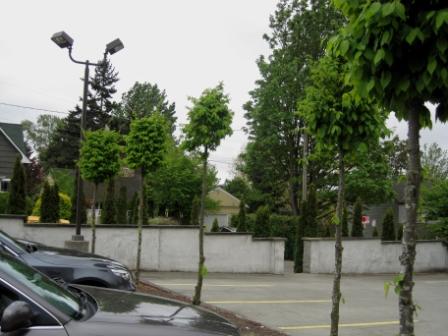Recently I posted that many of the “rules” that gardeners cling to so tightly regarding tree planting (i.e., dig the planting hole 3 times the width of the root ball, always amend the backfill with organic matter) are probably better considered ‘suggestions’ than rules. While these practices won’t hurt, there are much better ways to spend time and effort to ensure long-term survival when planting a tree. Here are the top four:
Irrigate. No matter how much time and effort goes into the ‘perfect’ planting hole; for most parts of the country, trees that are not irrigated after planting are doomed. Linda advocates watering in several small sips during the week; I still stick to the old school notion of one long soak per week. In the final analysis, logistics will probably dictate which approach you use. Either way, the key is to provide trees with water during the establishment year and even into the second year after planting, if possible.
Mulch. Organic matter placed properly on top of the planting hole will do more good than organic matter placed in the planting hole. Study after study demonstrates that mulch conserves soil moisture by reducing evaporation from the soil surface, controls weeds, and moderates soil temperature. Oh, and that business about wood-based mulches ‘tying up’ or ‘stealing’ nutrients from landscape plants? Maybe for bedding plants, but not for trees and shrubs. Our research and other studies indicate that, for the most part, the type of organic mulch makes little difference compared to not mulching at all. Hence, my motto “Mulch: Just do it.”

Proper planting depth. Width of the planting hole may not matter, but planting trees too deep is a recipe for disaster. Burying roots too deep reduces oxygen levels around the roots and starts a series of unfortunate events for the tree. Find the root collar flare and keep it visible.

Bad move. The contractor was going to install drain tile but decided not to at the last minute to save money. Ouch.
Right tree, right place. In my experience, the number one reason newly-planted trees fail in the first year is lack of watering and aftercare. After year one, improper tree selection takes the top spot. Here in the Upper Midwest, poor drainage and heavy soils take their toll year after year. Lack of water can usually be addressed, but once a tree is planted in a spot that is too wet for that species, it’s usually a long, slow, and agonizing decline. And it’s amazing how often people will ignore obvious red flags in selecting trees. Our Dept. of Transportation recently planted 25 eight-foot B&B eastern white pine, which are notoriously salt sensitive, about 30’ from I-96 at a rest area between Lansing and Detroit. Predictably, after one winter’s exposure to deicing salt spray all the trees were dead or wishing they were dead. Right tree, right place. This ain’t rocket science, folks.



















 The whole story
The whole story